



Many higher education institutions use annual faculty reviews to monitor progress, measure outcomes, and increase engagement. As faculty members meet with department chairs and other institution professionals, they gain feedback that propels their professional growth and aids institutional advancement.
These processes help uncover meaningful data and provide faculty with actionable insights to develop professionally. They also present an excellent opportunity for your staff to showcase accomplishments and highlight personal achievements. These reviews can help decision-makers determine promotions, such as tenure, and drive institutional change. Learn more about the importance of these reviews and how to set goals for them.
Faculty reviews are rigorous and objective evaluations to assess a faculty member’s performance. Faculty reviews comprise self-assessments and other evaluations to ensure your faculty is working effectively and continually contributing to improving themselves and your institution. An effective faculty review process can improve faculty productivity, close wage gaps, increase diversity, and positively change a higher education institution.
An annual faculty evaluation typically consists of preparing and reviewing a self-assessment, faculty panel scrutiny of documentation, and a panel visit to the faculty member. After completing the initial review process, the panel will create a report detailing the strengths and weaknesses of the faculty member and recommendations for improvement. The committee may also follow the report by devising an action plan for the faculty member to improve effectiveness and efficiency.
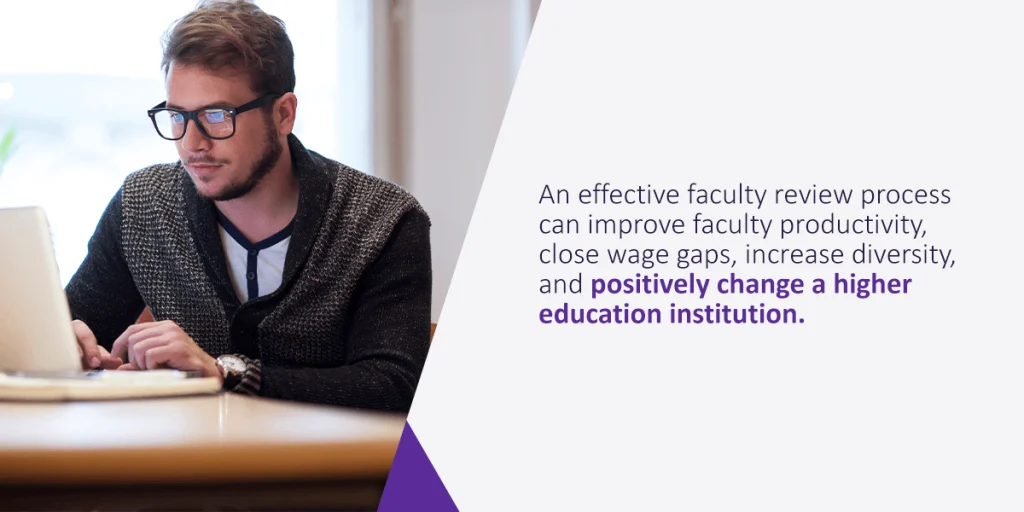
Faculty reviews allow your team to identify where they excel and where they need to improve. When your faculty continuously improves, your team and students can feel the effects on the learning environment. Faculty improvement can also contribute to your institution’s reputation.
Faculty reviews rely on qualitative and quantitative data to support decision-making, and both varieties offer different benefits:
These reviews enable your faculty to articulate their institution’s objectives and goals and measure the impact of these missions on your institution and students. You can further develop your team’s ability to assess themselves, each other, and your students through faculty evaluations.
Evaluations also contribute to a positive culture of change and allow team members to take immediate action toward improvement. When you detail action plans for your faculty, they know the actionable steps they can take to progress rather than staying at a plateau.
Faculty review data provides tons of meaningful information. Although many institutions understand the importance of these reviews, not every college and university knows how to use the data effectively. Along with helping your campus obtain far-reaching goals, you can use faculty review data to:
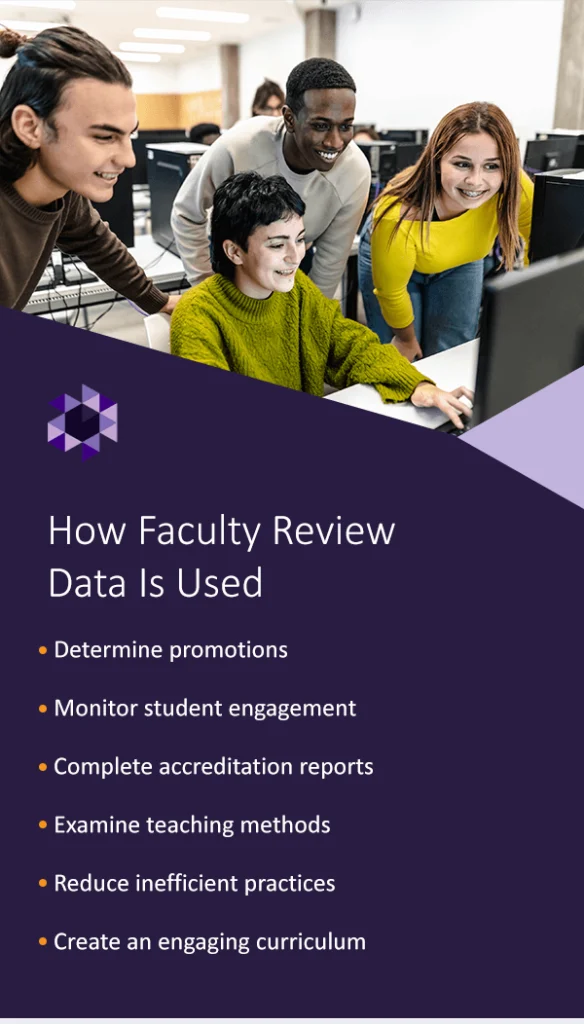
The faculty review process will generally begin with a professional consultation during a faculty member’s second year of service. The first faculty review can occur during the third service year. Around this time, faculty members will arrange a visit with the department chair, who may sit in on two classes.
After this visit, instructors can decide to meet to discuss their performance and areas of improvement. Once the committee completes the reports, they will ask the faculty member to meet and summarize the decision. This process can be lengthy, and we’ve detailed a breakdown of how it typically goes from start to finish.
One of the most essential components of faculty reviews is self-assessments. This comprehensive document outlines the achievements of faculty members and their progress over the academic year. You can also find faculty goals for the upcoming year in a self-assessment.
Faculty members need enough time to complete the self-assessment, and the chair needs adequate time to review it. These processes should remain separate and may require additional resources. The self-assessment should help keep the faculty member on track for tenure while meeting their personal goals. This task should not appear as busy work or interfere with other goals.
Once your faculty member completes their self-assessment, the department chair reviews it. This review involves evaluating the faculty member’s achievements, goals, and objectives. The department chair should recognize strengths and weaknesses and reinforce both aspects in the meeting with the faculty member. As important as it is to improve, it’s also essential to reinforce where a team member is excelling.
The chair will acknowledge areas that need growth or attention and consider opportunities for the faculty member to contribute to other institutional goals. As the chair works through the self-assessment, they should also allocate resources to help the faculty member reach the goals they’ve outlined. They will also recognize whether they need to discuss other topics, such as new initiatives or goals.
Some institutions operate with faculty portfolios, which are great documents to include in a faculty review. These documents showcase service statements, research, and teaching practices that have led your faculty member to success. You can easily access this information anytime if your institution utilizes faculty profiles to show achievements.
Although the chair may not be able to review each faculty member’s profile, encourage them to discuss the importance of updating profiles with your team. These comprehensive profiles can make it much easier for your team to gather the materials they need for the review process and give your faculty a convenient location to build their accomplishments and prepare for their reviews.
These profiles can also aid student decisions about whether they would like to attend your institution or a particular course. Similar to your chair, students can access these profiles at any time and evaluate the credentials of your instructors.
Course evaluations and other faculty assessments are incredibly valuable during faculty reviews, especially if the faculty member is an instructor. These assessments detail what students enjoyed about a course and what areas need improvement. Other team members may also have feedback for the faculty. If your institution has a mentoring program, department chairs can speak with the student mentee or professional mentor about the faculty member’s performance.
Course evaluations are also an excellent opportunity to examine where there may be a disconnect between course materials and student success. Students who detailed they did not enjoy a course but received exceptional grades may indicate a disconnect between teaching methods and course curriculum. Perhaps instructors need to evaluate whether or not lectures need to be more exciting or assignments are too easy.
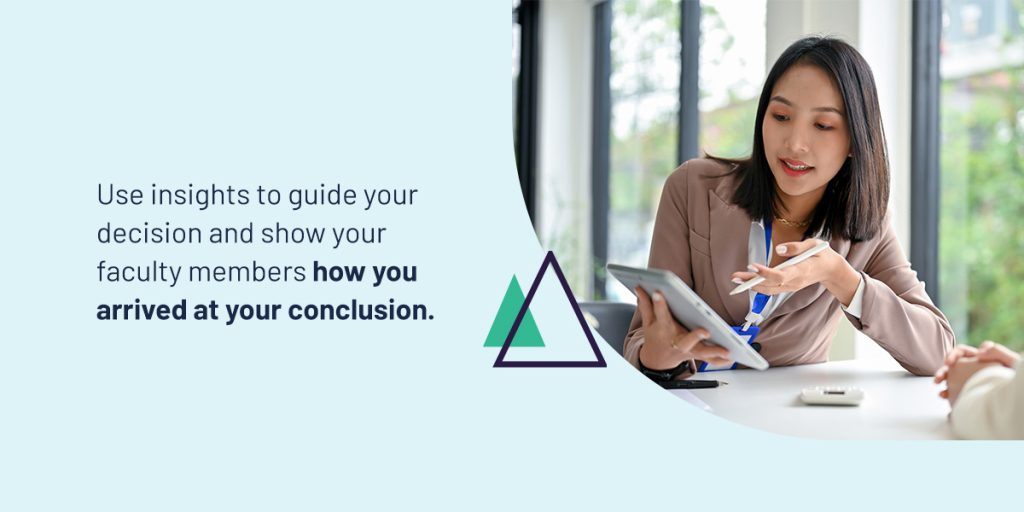
While analyzing course and faculty evaluations, it is beneficial to leverage additional data and insights. Information showcasing student performance and achievement and reports detailing program and course success can highlight adverse or positive changes your faculty needs to address. It may also be helpful to refer to curriculum maps during this process to identify where professors may have strayed from proposed plans or how to improve courses for the future.
Data will also be especially helpful for tenure review processes. You can use this information to determine the performance of the faculty member over the last several years. You can determine student progress to determine whether professors are making positive course changes and evaluate success rates to establish whether a program is more effective with new changes. Whether you decide to offer tenure, raise compensation, or provide different benefits, you can use these insights to guide your decision and show your faculty members how you arrived at your conclusion.
One of the most crucial aspects of the annual review process is making recommendations and following up. It is critical to ensure your faculty understands your expectations and the action items they can complete to generate positive change. Communicating your initiatives and establishing baselines can ensure each faculty member has the understanding to meet your goals and contribute to a campus culture of continuous improvement.
You should also establish a timeframe for evaluating whether the faculty member implemented your recommended changes and whether those changes are successful for your students and institution. Checking in with your staff can reinforce the importance of your initiatives and suggestions for change. Additionally, these check-ins can serve as an opportunity for staff to ask questions or gain more clarity.
For example, if a professor is facing challenges with integrating new course materials, as you discussed in their review, they can express the issue and strike up a conversation about how to address the problem. This process allows your staff to know you care about their progress while ensuring their actions continue to align with your vision. Additionally, this enhanced communication can foster more collaboration across departments as faculty members seek to discover what others have done to meet and exceed your expectations.
The faculty review process begins with preparation from the faculty member and the department chair. Department chairs select data points and craft the self-assessment form to kickstart the process. They review information, like portfolios and evaluations. Chairs will also need to arrange the meeting agenda. Department chairs then determine whether discussions will focus on campus-wide initiatives, professional growth and success, or departmental goals.
Teaching is a challenging topic to master, and evaluating your professors can help your students receive the highest-quality instruction and materials. Finding the right questions is essential to gathering the meaningful information you need to evaluate teaching practices.
A faculty annual review sample for an instructor may feature questions like:
This list is by no means exhaustive but details a range of questions. Students can discuss an instructor’s professionalism, course expectations, curriculum creativity, and topic enthusiasm. Student responses can give insight into their experience and where the faculty member excels or needs to improve.
Communicating effective feedback can be a challenge. Constructive criticism is one of the most critical aspects of the faculty review process — this is where your team will understand how they can improve to benefit themselves and your institution. Feedback is valuable, and giving actionable steps toward improvement guides faculty members toward making meaningful change.
Explain to your faculty why you want them to make a change. They can keep these objectives in their mind and distinguish between something they’ve done wrong and something they can do better.
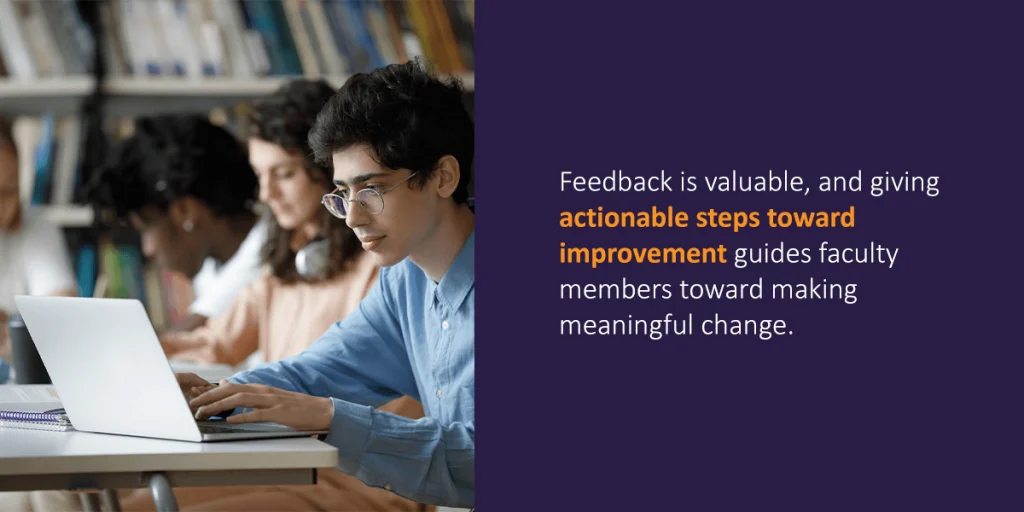
When you portray feedback in the right way, it can become a catalyst for change rather than a harsh remark. This can shape the conversation to flow from what is currently wrong to what will be correct in the future.
When giving constructive criticism, you should:
Setting realistic goals and objectives can lead your faculty to improve campus culture and student experiences. Goals are typically more long-term tasks that take a few years to complete. Goals may include securing department funding or increasing teaching efficiency.
Objectives are short-term tasks that your faculty can focus on for the following year. These tasks are measurable and could include items like submitting two applications for funding, enrolling in a training program, or completing a project by a deadline.
It would be helpful for your faculty member if you place goals and objectives in priority order. Discuss tasks you would like your team members to dedicate the most time and effort to first. Clearly state your intentions for setting the goal or objective and detail why you think it would benefit your faculty to take a particular action.
Make these tasks actionable and time-bound for the best results. “Complete training by the start of next semester” could be an approachable objective.
Although feedback is important for progress, not every faculty or staff member will view it that way. Some people cannot take criticism well, and others may feel hurt. Knowing how to respond to various reactions helps keep a professional tone during faculty reviews.
Reactions you may face include:
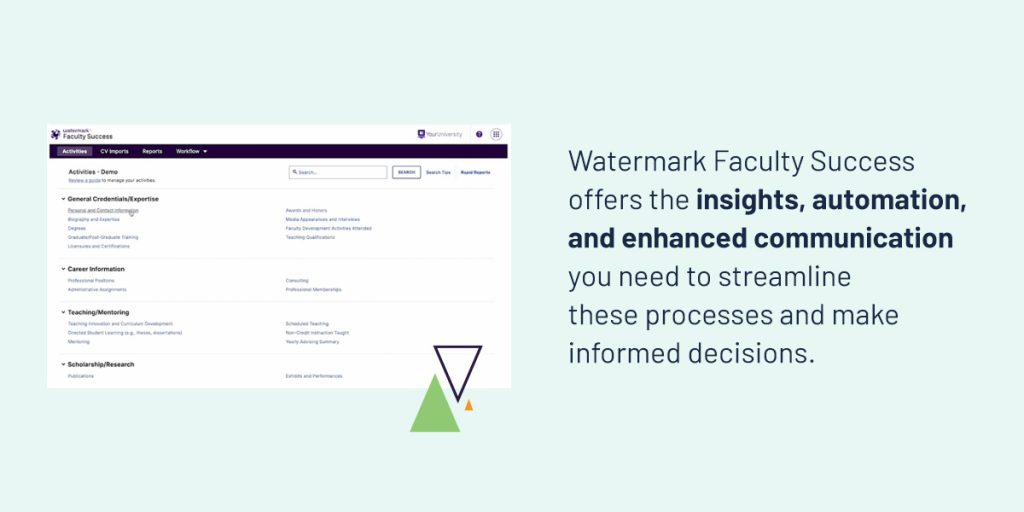
The annual review process can be simple with the right tools. Watermark Faculty Success offers the insights, automation, and enhanced communication you need to streamline these processes and make informed decisions. This solution can highlight which items are most critical for faculty reviews, create process consistency, showcase your faculty achievements, and provide the configurability necessary to meet unique institutional goals and needs.
Faculty Success is a central hub of activity and insights, allowing you to generate custom reports and enhance collaboration and understanding across departments. You can use this software to confirm faculty credentials, automate web profile updates, and capture a holistic picture of discipline-specific details.
Many higher education institutions have utilized Faculty Success to drive change across campus. Along with guiding reviews, this solution can empower institutions to make long-lasting changes. From preventing institutional shutdowns to revolutionizing accreditation prep and more, many colleges and universities have unlocked the power of Faculty Success to guide annual reviews and drive institutional shifts.
Watermark is constantly looking for ways to improve student experiences and drive meaningful change at higher education institutions. Our Faculty Success software makes it easy to keep faculty data current and easily accessible.
Watermark’s Faculty Success allows you to track faculty achievements and manage all incoming data easily. This information can aid in annual faculty reviews, strategic planning, and accreditation reports. No matter what you need, you can quickly access information with our program from anywhere. With customizable reports, faculty profiles, and self-serving reporting options, you can quickly turn your faculty data into actionable insights that improve your institution.
Request a demo of Watermark Faculty Success today. Start reaching your faculty evaluation goals with Watermark.






























































































































































































































































































































































































